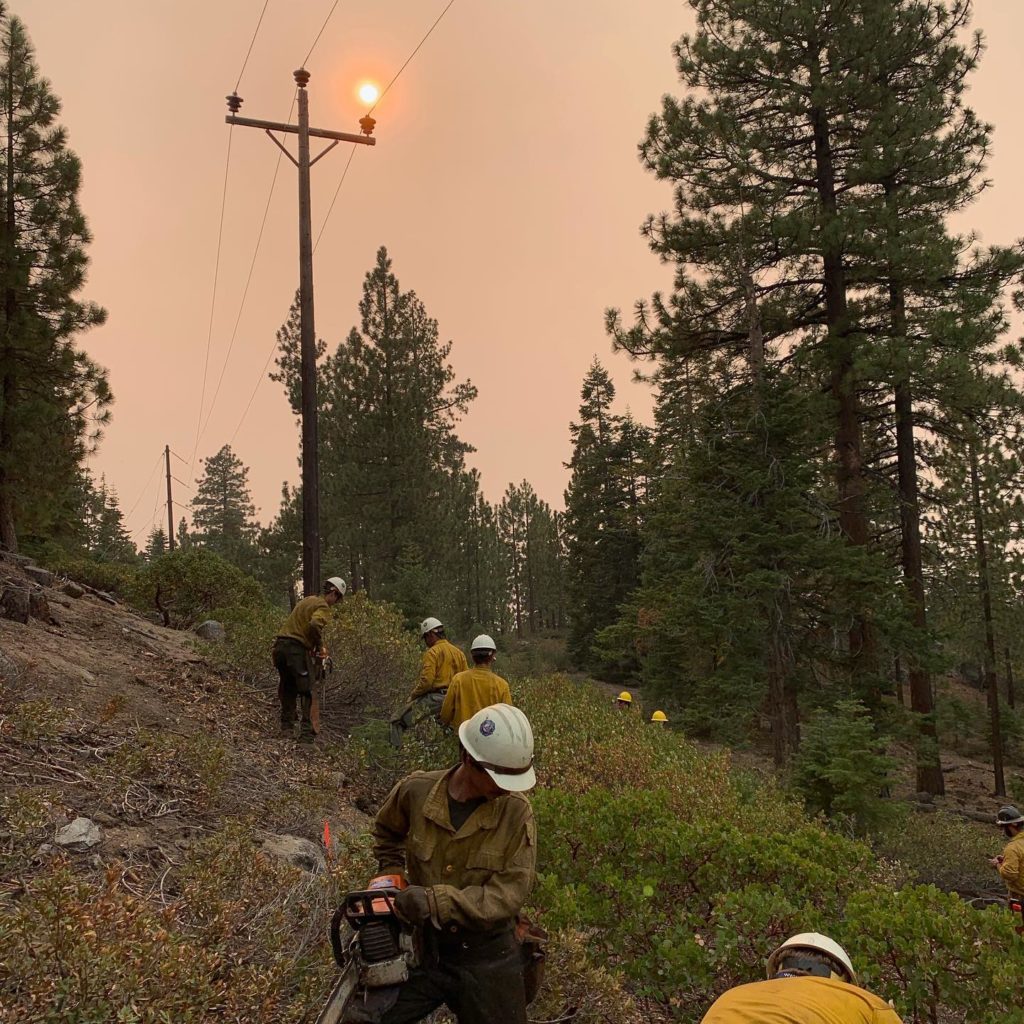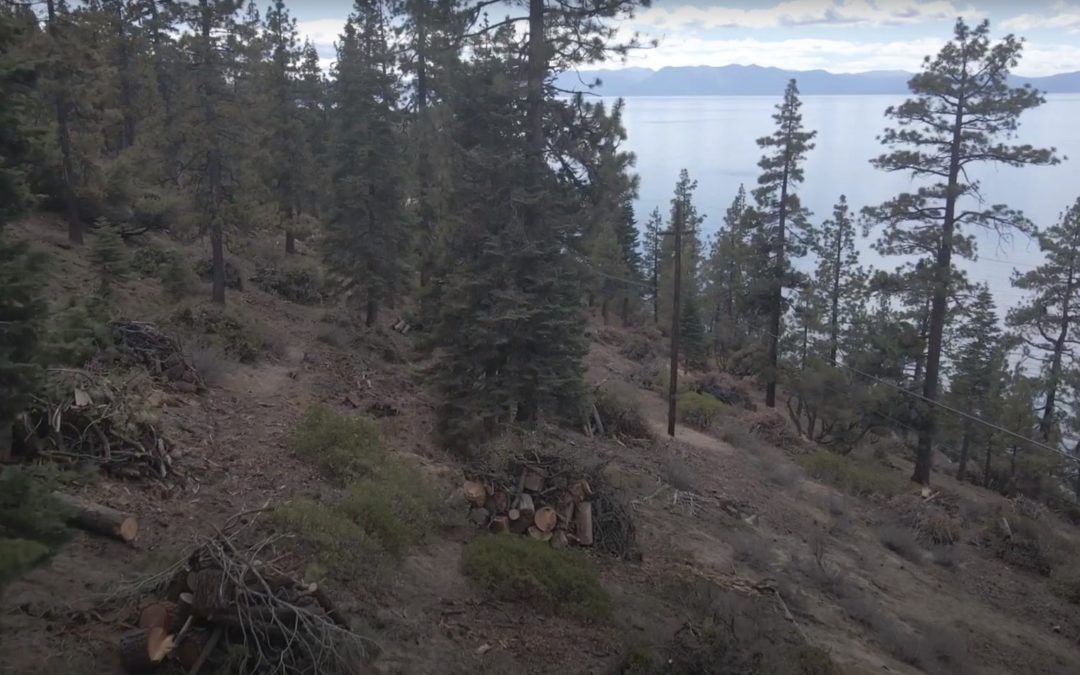Vote expands mechanized equipment use on steep slopes
Lake Tahoe, CA/NV – The Tahoe Regional Planning Agency (TRPA) Governing Board today approved policy changes that will help increase the pace and scale of forestry work in the Lake Tahoe Region to reduce the threat of catastrophic wildfire.
The decision expands the areas where ground-based mechanical equipment can be used on steep slopes. The new policy will promote forest and ecosystem resilience to disturbances such as climate change, the agency said today.
Steep terrain can be more difficult and resource intensive for land managers to reduce hazardous forest fuels. Prior to the update, Lake Tahoe agencies could use ground-based mechanical equipment on slopes up to a 30 percent gradient, while work on steeper slopes was limited to hand crews, pile burning, and aerial logging to protect water quality from potential erosion.

Crews with North Lake Tahoe Fire Protection District reduce fuels on a slope near Incline Village, Nevada. Photo courtesy of NV Energy.
Research recently completed in partnership with the USDA Forest Service Pacific Southwest Research Station and the University of Idaho, showed that the use of newer mechanical equipment in combination with hand crews on slopes between 30 and 50 percent would not cause significant impacts to the watershed. The research also showed the new policy would increase forest and ecosystem resilience to disturbances such as fire, insects and disease, and climate change.
“The Caldor Fire and the surge of megafires in the region are clear directives for us to improve our forest health policies to better protect communities and the environment from wildfire,” TRPA Executive Director Joanne S. Marchetta said. “TRPA is committed to advancing science-based practices that protect the lake and bolster our resilience to ever-growing wildfire threats, especially given the need for fuels reduction work in untreated areas narrowly missed by the Caldor Fire.”
The policy change will facilitate additional forest health projects on steeper slopes. Approximately 61,000 acres in the Tahoe Basin have slopes from 30 to 50 percent, and nearly half of that area is in wildland urban interface defense and threat zones near communities where hand crews continue to work. Additionally, post-fire assessments of the Caldor Fire show that steeper slopes tended to burn at higher severity than other areas.
“This is a game changer for fuels reduction in the basin,” Chief Scott Lindgren of Tahoe Douglas Fire Protection District said. “Hilly terrain is a significant portion of the Tahoe Basin and with the right kind of equipment, we can do quality fuel reduction work and protect the environment at the same time.”
Although Lake Tahoe communities were largely spared from the destruction of last year’s Caldor Fire, nearly 250 Tahoe homes were lost to the wind-whipped Angora Fire in 2007. Following Angora, TRPA helped form the Tahoe Fire and Fuels Team (TFFT), which has led to greater coordination, streamlined policies, increased fuels management, and a greater focus on homeowner defensible space, according to the agency. Since then, TFFT partners have treated more than 68,000 acres for fuels reduction and have conducted 55,000 homeowner defensible space inspections.
Previous TRPA forest health policy changes allowed homeowners greater flexibility in tree removal and expanded options for hand crews working in Tahoe’s sensitive stream environment zones including the use of mechanical equipment over snow and frozen ground. These updates increase capacity and help projects continue during more of the year, which is increasingly important as climate change shifts snowfall and precipitation patterns in the region, according to TRPA.
Climate change is causing rapid changes in Lake Tahoe forests that increase the threat of catastrophic wildfire to community safety and the environment. New landscape restoration strategies are coming forward to treat much larger, interconnected areas and incorporate multiple-benefits such as the 59,000-acre Lake Tahoe West project. More than 77 percent of areas affected by today’s forest health policy change are on federal lands.
“The Forest Service and our partners have made great strides toward increasing the pace and scale of forest health treatments in Lake Tahoe forests, but there is much more work to be done,” said Forest Supervisor, Erick Walker. “By exploring new ideas and expanding treatment methods in challenging areas, we can provide land managers with more effective tools to help restore forests and increase landscape resilience. TRPA’s amendment allows the Forest Service to consider the use of equipment on steeper slopes when and where appropriate, to treat and remove forest fuels where the only option had been to hand thin, pile, and burn.”
“Mechanical thinning can be a much more efficient and effective option when used in suitable locations, especially when hand crew capacity is a limiting factor,” Walker added. “This change will help increase the pace and scale of forest restoration to meet the goals of the Lake Tahoe Basin’s Multi-Jurisdictional Fuels Strategy and would contribute to Forest Service efforts to advance forest health in collaboration with partners nationwide through our newly launched 10-year strategy, Confronting the Wildfire Crisis: A Strategy for Protecting Communities and Improving Resilience in America’s Forests.”
The Tahoe Regional Planning Agency leads the cooperative effort to preserve, restore, and enhance the unique natural and human environment of the Lake Tahoe Region, while improving local communities, and people’s interactions with our irreplaceable environment. For additional information, contact Jeff Cowen, Public Information Officer, at (775) 589-5278 or jcowen@trpa.gov.

